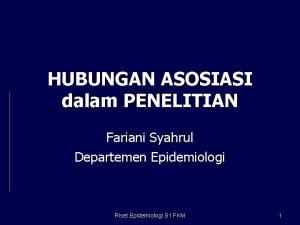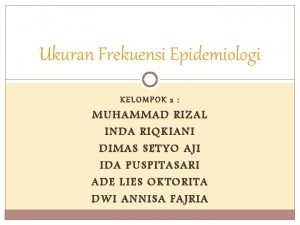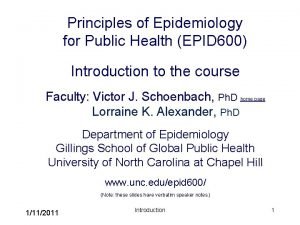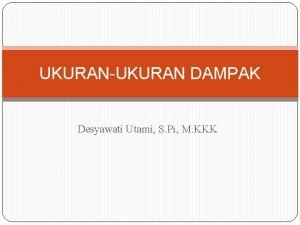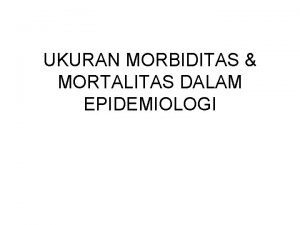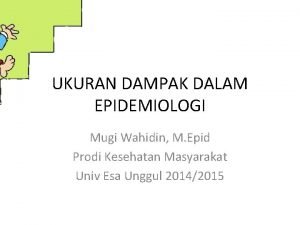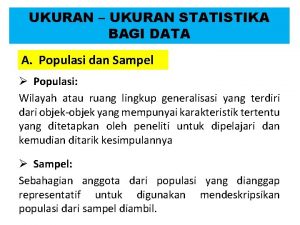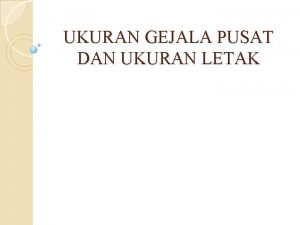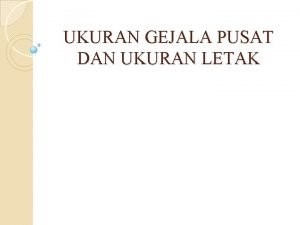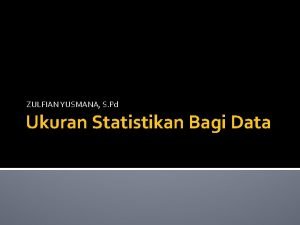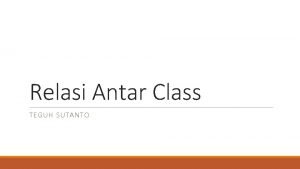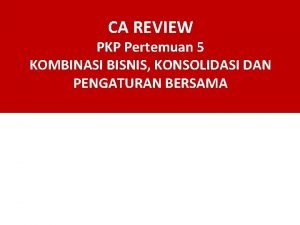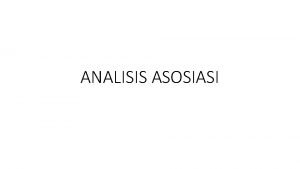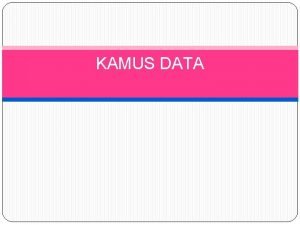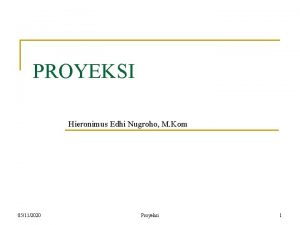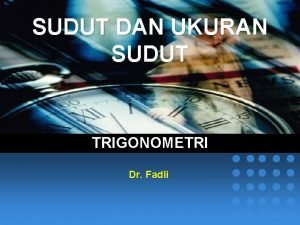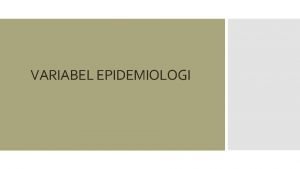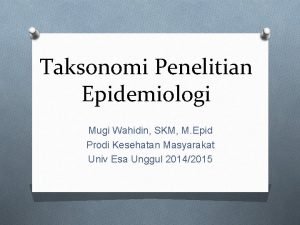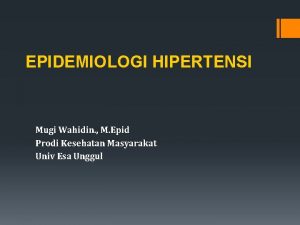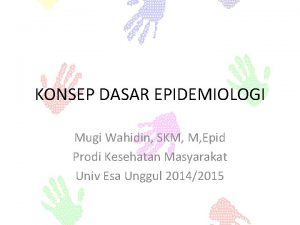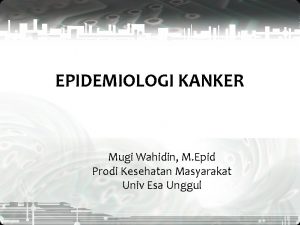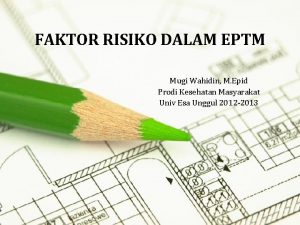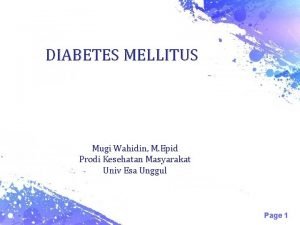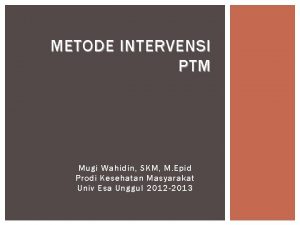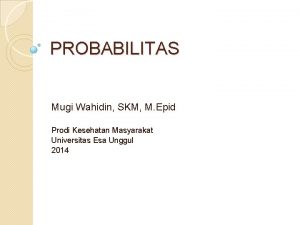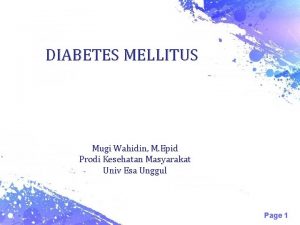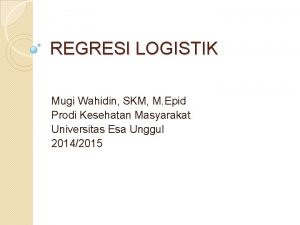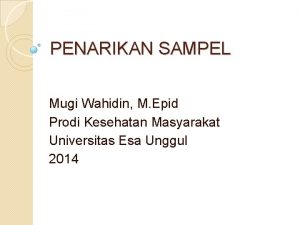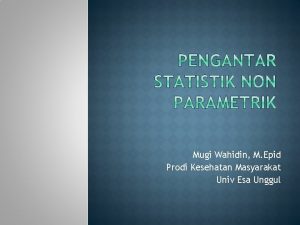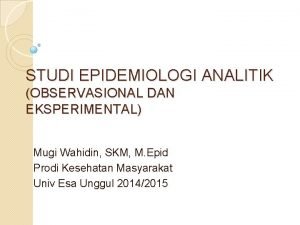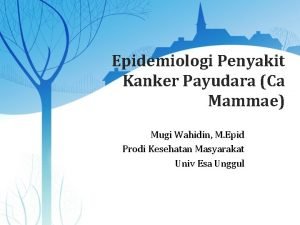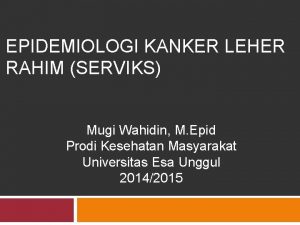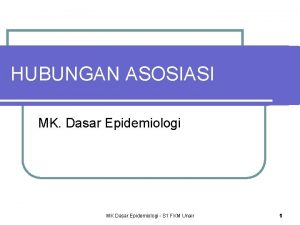UKURAN ASOSIASI DALAM EPIDEMIOLOGI Mugi Wahidin M Epid




































- Slides: 36

UKURAN ASOSIASI DALAM EPIDEMIOLOGI Mugi Wahidin, M. Epid Prodi Kesehatan Masyarakat Univ Esa Unggul 2012/2013

POKOK BAHASAN • Pengertian ukuran asosiasi • Jenis ukuran asosiasi – RR – OR – PR • Perhitungan

UKURAN FREKUENSI DALAM KESEHATAN MASYARAKAT • Tipe Kuantitas matematis 1. 2. 3. 4. Jumlah (enumerasi, counts) Rasio Proporsi Rate (angka, laju) • Tipe Ukuran epid 1. Frekuensi: insidens, prevalens, mortalitas 2. Asosiasi: risk ratio, prevalens ratio, odds ratio 3. Dampak: Attributable Risk, % Attributable Risk, Prefented Fraction

UKURAN ASOSIASI • Relative : – RR (relative risk) Studi Cohort • Risk ratio • Rate ratio – Odds Ratio (OR) , Prevalence Odds Ratio (POR) studi case control – Prevalence Ratio (PR) studi cross sectional • Absolute : – RD (risk difference) Studi cohort

UKURAN ASOSIASI • Studi Cohort Risk Ratio (RR) • Studi case control Odds Ratio (OR) • Studi cross sectional Prevalence Ratio (PR)

Tipe ukuran yang digunakan dalam epidemiologi • Ukuran asosiasi – Merefleksikan kekuatan atau besar asosiasi antara suatu eksposur/faktor risiko dan kejadian suatu penyakit – Memasukkan suatu perbandingan frekuensi penyakit antara dua atau lebih kelompok dengan berbagai derajat eksposur – Beberapa ukuran assosiasi digunakan untuk mengestimasi efek

Basic Question in Analytic Epidemiology • Are exposure and disease linked? Exposure Disease

Ukuran-ukuran asosiasi • Ukuran rasio (perbandingan relatif) – rasio dua frekuensi penyakit membandingkan kelompok terpajan dengan kelompok tidak terpajan • Ukuran perbedaan efek (perbandingan absolut) – perbedaan antara ukuran frekuensi penyakit suatu kelompok terpajan dan kelompok yang tidak terpajan

Two-By-Two Table Disease Yes Exposure Yes No Total a b a+b c d c+d No Total a+c b+d a+b+c+d

Hypothetical Two-By-Two Table Lung cancer Yes Smoking Yes No 70 300 370 15 700 715 Total No Total 85 1, 000 1, 085

Relative Risk (RR) • Measures how likely the exposed group will develop a disease compared to the unexposed group. RR = incidence in the exposed = a/(a+b) incidence in the unexposed c/(c+d)

Example: Hypothetical Study Lung cancer Yes Smoking No Total Yes 70 300 370 No 15 700 715 1, 000 1, 085 Total 85

Relative Risk (RR) Relative Risk = 70/(70+300) = 9. 0 15/(15+700) Which means… participants who smoked were 9 times more likely to develop lung cancer than those who did not smoke.

Relative Risk (RR) RR of 1. 0 indicates that the occurrence of disease in the exposed an unexposed groups are identical: – No association observed between exposed and unexposed groups.

Relative Risk (RR) • RR greater than 1. 0 indicates a positive association, or an increased risk among the exposed. • RR less than 1. 0 means that there is a decreased risk among the exposed group.

Ukuran-ukuran asosiasi • Ukuran rasio – Rasio risiko atau risiko relatif (RR) – Rasio Insidens Kumulatif (RIK)

Perhitungan RR untuk CI Outcome (+) Outcome (-) Total E (exposed) a b a+b NE (unexposed) c d c+d Total a+c b+d N (a + b + c + d) CI pada populasi exposed (E) --- a/(a + b) RR= CI pada populasi unexposed (NE) --- c/(c + d)

THEN, FIRST, SELECT FOLLOW TO SEE WHETHER Incidence rates Totals of Disease Develops Disease Does Not Develop Exposed a b a+b a Incidence in = exposed a+b Not Exposed c d c+d c Incidence in = c+d non-exposed Relative Risk ( RR ) = incidence in exposed incidence in non-exposed = a a+b c c+d

Example : A Prospective Study of 3, 000 Smokers and 5, 000 Nonsmokers to Investigate Smoking and Coronary Heart Disease (CHD) THEN FOLLOW UP TO SEE HOW MANY Develop CHD FIRST, SELECT Do Not Incidence Develop Total per 1, 000 per year CHD Healthy Smokers 84 2, 916 3, 000 28. 0 Healthy Non. Smokers 87 4, 913 5, 000 17. 4

Contoh 5. Tabel 1. Kaitan antara merokok dan angka insidens stroke dalam suatu kohort. Kategori merokok Tidak pernah merokok Mantan perokok Perokok Total Jumlah kasus stroke Orang-tahun observasi (lebih dari 8 tahun) Tingkat insidens stroke (per 100. 000 orang tahun) 70 395. 594 17, 7 65 139 232. 712 280. 141 27, 9 49, 6 274 908. 447 30, 2 Sumber: diterjemahkan dari: Beaglehole et al. Basic Epidemiology. WHO. 1993. 18.

Postmenopausal Hormone Supplement and CHD Ever use Past use Current Never use CHD Person-years 30 19 11 60 54, 308. 7 24, 386. 7 29, 922. 0 51, 477. 5 RR ever use vs never use = (30/54, 308. 7) / ( 60/51477. 5) = 0. 5 RR past use vs never use = (19/24386. 7) / (60/51477. 5) = 0. 7 RR current use vs never use = (11/29922. 0) / (60/51477. 5) = 0. 3

Prevalence Ratio (PR) – Prevalence Ratio (PR) • Untuk kasus prevalens pada studi corss sectional survey • Sama seperti perhitungan RR,

THEN, FIRST, SELECT FOLLOW TO SEE WHETHER Prevalenc e rates Totals of Disease Develops Disease Does Not Develop Exposed a b a+b Not Exposed c d c+d Prevalence Ratio ( RR ) = Prevelence in exposed Prevelance in non-exposed= a a+b c c+d a Prevalence = in exposed a+b c Prevalence = c+d in nonexposed

Rasio odds (Odds ratio = OR) • Ukuran rasio – Rasio odds (Odds ratio = OR) • Nama lain: Odds relative; rasio kros-produk • rasio dua odds yang digunakan dalam studi kasuskontrol untuk mengestimasi rasio rate atau rasio risiko

Rasio odds (Odds ratio = OR) • Ukuran rasio – Rasio odds (Odds ratio = OR) • odds untuk satu kelompok dibagi dengan odds untuk kelompok yang lain • Mempunyai interpretasi yang sama seperti risiko relatif

Rasio odds (Odds ratio = OR) • Odds suatu kejadian – rasio probabilitas bahwa kejadian terjadi terhadap probabilitas kejadian tidak terjadi P 1–P = Probabilitas suatu kejadian terjadi = Probabilitas suatu kejadian tidak terjadi

Figure 11 -5 A, Odds ratio (OR) in a cohort study. B, Odds ratio (OR) in a case-control study. Downloaded from: Student. Consult (on 8 October 2009 11: 44 AM) © 2005 Elsevier

Prevalence Odds Ratio (POR) = Cross Product Ratio bila data didasarkan pada kasus-kasus prevalens Faktor Perokok Kasus 650 (a) Kontrol 950 (b) Total 1600 Bukan perokok Total 50 (c) 350 (d) 400 700 1300 2000

The odds ratio ( relative odds) is a good approximation of the relative risk when : 1. The cases are representative of all cases with regard to exposure; 2. The controls are representative of all control with regard to exposure; = 3. The disease being studied is

Odds Ratio & Risk Ratio The odds ratio will provide a good estimate of the risk ratio when: 1. The outcome (disease) is rare E+ E- D+ a c Db d OR = (a / c) / (b / d) OR = (ad) / (bc) a / (a +b ) RR = ------c / (c +d) If the disease is rare, then cells (a) and (c) will be small a / (a +b ) a / b ad RR = ------ =___ OR c / (c +d) c / d bc

Figure 11 -6 Example: The odds ratio is a good estimate of the relative risk when a disease is infrequent. Downloaded from: Student. Consult (on 8 October 2009 11: 44 AM) © 2005 Elsevier

Figure 11 -7 Example: The odds ratio is not a good estimate of the relative risk when a disease is not infrequent. Downloaded from: Student. Consult (on 8 October 2009 11: 44 AM) © 2005 Elsevier

In a prospective study/cohort study, the Relative Risk can be calculated directly In a retrospective study /case control study , the RR cannot be calculated directly, so that the Relative Odds or ODDS RATIO ( Cross Products Ratio ) is used as an estimate of the RR, when the risk of the disease is low

OR & RR • Pada penyakit yang jarang terjadi, nilai Odds Ratio hampir sama dengan nilai Relative Risk (Risk Ratio). Nilai Prevalence Odds Ratio hampir sama dengan nilai Prevalence Proportion Ratio. • Pada penyakit yang umum terjadi, nilai Odds Ratio lebih ekstrim dari pada Risk Ratio.

Interpretation of Odds Ratio • Relative odds associated with exposure OR = 1 no association OR > 1 positive association OR < 1 negative association • Size of OR indicates strength of association • OR ≈ RR when disease rare (i. e. , risk < 5%); when disease not rare, OR still a valid measure of association Gerstman Chapter 8 (partial) 35

Thank You
 Ukuran asosiasi adalah
Ukuran asosiasi adalah Association causality
Association causality Contoh soal rate epidemiologi
Contoh soal rate epidemiologi Epid 600 unc
Epid 600 unc Population attributable risk adalah
Population attributable risk adalah Pengertian case fatality rate
Pengertian case fatality rate Population attributable risk adalah
Population attributable risk adalah Rumus koefisien kemiringan pertama dari pearson
Rumus koefisien kemiringan pertama dari pearson Ukuran ukuran statistik
Ukuran ukuran statistik Ukuran gejala pusat dan ukuran letak
Ukuran gejala pusat dan ukuran letak Modus adalah
Modus adalah Ukuran kepala gambar
Ukuran kepala gambar Ukuran gejala pusat dan ukuran letak
Ukuran gejala pusat dan ukuran letak Dkv
Dkv Entitas asosiasi
Entitas asosiasi Asosiasi adalah
Asosiasi adalah Contoh efek tyndall dalam kehidupan sehari-hari
Contoh efek tyndall dalam kehidupan sehari-hari Asosiasi adalah
Asosiasi adalah Relasi antar class
Relasi antar class Investasi pada entitas asosiasi adalah
Investasi pada entitas asosiasi adalah Koloid liofob contoh
Koloid liofob contoh Entitas asosiasi adalah
Entitas asosiasi adalah Asosiasi konstruksi yang diakui pemerintah
Asosiasi konstruksi yang diakui pemerintah Kombinasi bisnis dan konsolidasi
Kombinasi bisnis dan konsolidasi Asosiasi adalah
Asosiasi adalah Contoh soal ilmu ukur tanah
Contoh soal ilmu ukur tanah Penunjukan ukuran jari-jari adalah dengan cara
Penunjukan ukuran jari-jari adalah dengan cara Kamus data
Kamus data Proyeksi dimana 3 muka dipendekkan dalam ukuran yang sama
Proyeksi dimana 3 muka dipendekkan dalam ukuran yang sama Apa itu dimensi gambar
Apa itu dimensi gambar Ukuran organisasi dalam tahapan pertumbuhannya
Ukuran organisasi dalam tahapan pertumbuhannya Pengertian ukuran sudut
Pengertian ukuran sudut Bentuk baku dalam satuan si
Bentuk baku dalam satuan si Epidemiologi deskriptif adalah
Epidemiologi deskriptif adalah Variabel tempat
Variabel tempat Proporsi epidemiologi adalah
Proporsi epidemiologi adalah Surveilans epidemiologi adalah
Surveilans epidemiologi adalah

